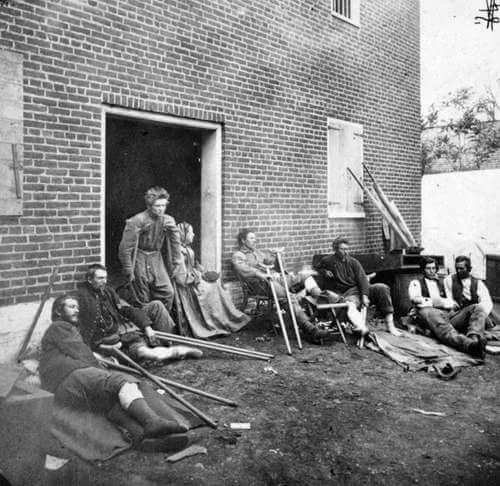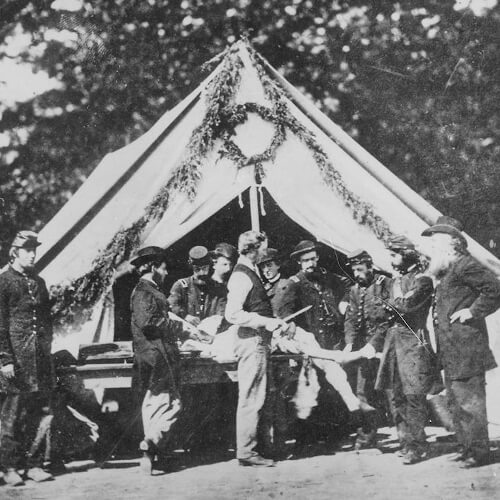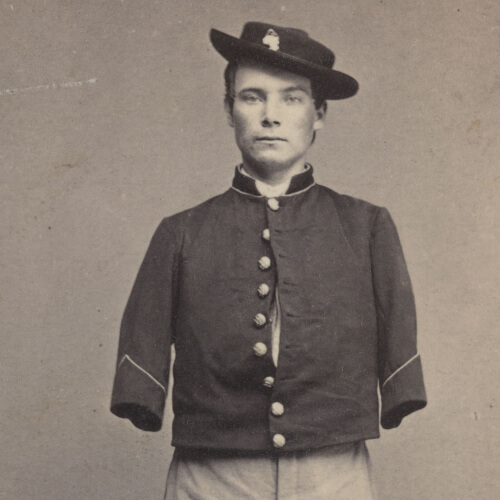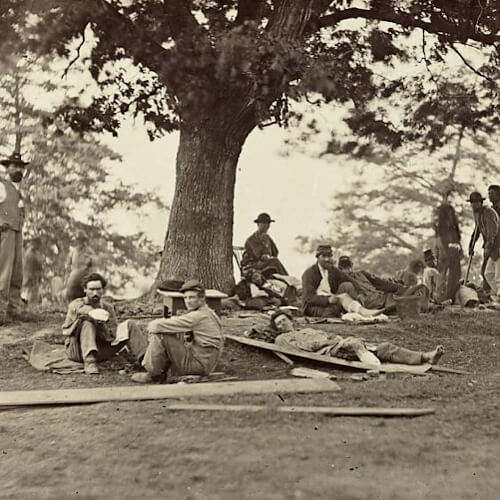Civil War Medicine
Exploring the medical practices and personnel during the Civil WarCivil War Era Medicine
Medicine during the Civil War was primitive compared to the medicine today. Our understanding of disease, surgery, and sanitation was limited. Anesthesia was a recent discovery and most doctors had only minimal schooling. More people died from disease than from battle injuries. Surgery was the most common solution to bullet wounds. Field hospitals were cramped and dirty, making all soldiers prone to infection. Experiences during the Civil War led doctors to many medical advances.
Triaging the Wounded
Health care at the time was primitive, and therefore the diagnoses and treatments of the various patients was primitive as well, and also rushed because the fact that a war was going on did not help with the situation. First off, the idea of pharmacies was extremely basic and undeveloped. In addition to that, modern antibiotics were unavailable, and sterilization by heat was unknown. The idea of applying antiseptics to surgery patients did not catch on until 10 to 15 years after its invention by Joseph Lister of Europe in 1867. However, most disturbing was how it was thought that the body “sought to cure itself by excreting toxins”, meaning that any release of bodily fluids (vomit, diarrhea, blood, etc.) from infections was encouraged by doctors and nurses, who thought that this would help cure a person from whatever ailment they suffered. Doctors and nurses often observed bodily fluids such as urine, feces, blood, and pus to attempt to make a diagnosis to the problem.
Anesthetics
Anesthetics such as chloroform and ether were used on soldiers just before they were operated on. Chloroform was used during most of the operations as it took the little amount needed for it to render the patient unconscious. However, applying the anesthetics was difficult and they were only used at the absolute necessary times. The anesthetic temporarily prevented the flow of oxygen through the body and could kill people. There were different techniques on how to administer the anesthetic safely. The most common way was that the doctor would take a paper cloth and fold it into a cone shape. Then he would take a sponge soaked with the anesthetic and place it on the apex of the cone. He would place the cone with the sponge far away from the soldier and slowly move it forwards until the desired effect was achieved. He would do this so the anesthetic was diluted with air in the beginning, making the operation safer. A surgeon in the south, J.J. Chisolm made another device that would have two nose pieces to insert into the patient. In the South, there was a shortage of anesthetics, so Chisolm was forced to think of a device that conserved the most chemical. He made a cylindrical tube with a small, grated plate where he would drop the anesthetic in. It looked roughly like the image on the right. On average, ten people per one thousand would die because of the anesthetic. In rare cases anesthetics were not available to the people, they would be given liquor and had to go through all the pain of amputation. When this happened, it was rare that the person would survive.
Amputations
Although amputations may have seemed very common during the Civil War, they were really only the most radical treatment of only the most extreme gunshot wounds. Amputations were the most common after large battles with many wounded men, where doctors would be forced to go through men as quickly as possible, usually through these large surgeries such as amputation. During earlier battles, less knowledgeable doctors amputated only to gain experience in the field. Doctors were forced to decide on certain criteria for determining if amputation was needed. The bullets normally used during the Civil War were known as “minié balls”, which would drastically change shape when in contact with the soldier’s body, and in turn, would create a larger entrance and exit wounds with mangled body tissue and shattered bones. It was when a soldier suffered from either these conditions or major damage to important nerves and/or blood vessels that they became likely contestants for an amputation. Because of the high demand for fast and efficient treatment, doctors needed to make quick treatment choices. They tended to use visual analysis and finger probing to examine wounds that may have needed amputation and to see if there was a high risk of bleeding or infection if the limb was not amputated. There were three types of amputations: “primary” (performed within the first 48 hours), “intermediate” (performed between the first three days and the first month), and “secondary” (performed after the first month). Regarding amputations, the sooner the better: if doctors felt that amputation would most likely be needed, then the doctors had to make their decisions, and fast. In addition, the location of the wound was crucial; the farther it was from the trunk (torso), the better, meaning that arm amputees had a lower mortality rate than leg amputees; however, amputations at any joint had increased risk, and amputations at the hip had the highest death rate.
Ambulances and Medical Transportation
Near the beginning of the Civil War, the Union medical department had close to no ambulances. As the fighting continued, a useful system for transporting soldiers in an organized fashion with assigned personnel was developed in order to better take patients from one location to the next. Before this new and improved system was developed, wounded soldiers were generally transported by either wagon or farm cart, because ambulances were not used until 1859. In 1859, near the birth of these new ambulances, a group of army men chose a few different designs to use during the war, which were to be tested in the west. These designs were, for the most part, based on the ideas of ambulances used by armies in Europe during the Crimean War. In the early part of the Civil War, ambulances were scarce and very limited. A Union general, Irvin McDowell, only had 50 ambulances that were to be used for his troop of 35,000 at the first Bull Run in July of 1861. In addition to this, a large portion of these 50 ambulances had two wheels and were pulled by horses or mules, which made for slow travel. These two-wheeled carts could only hold a maximum of three patients, and further injured the soldiers by taking them over bumpy roads and constantly overturning or breaking down. However, two years into the war, two-wheeled ambulances were scarce and had been almost totally replaced by four-wheeled vehicles. There were always some variations regarding the different types of ambulances, but the basic types were a lighter type, which used two horses, and a heavier type, which used four horses. The ambulances with four horses were of course larger, meaning that they could hold more patients at a time. The largest ambulances could carry approximately four to six men on stretchers, while two could be hung from the roof and others could sit up by themselves and did not need the assistance of stretchers. Although ambulances constantly developed throughout the war, because of the badly paved roads, transportation for patients could never be comfortable.
Additional Information
Hand Litters
Hand litters were stretchers that soldiers used to carry the wounded back to field hospitals. These devices were small and compact, making them easy for transport, and could also be assembled very quickly. It was made of canvas with two loops on both sides. Two ash wood sticks would be placed through the loops and two soldiers would place the wounded soldier on the canvas. Then they would both grab hold of the poles and be able to carry the wounded soldier to safety. The main hand litter at the beginning of the war was the Satterlee litter. It weighed twenty-five pounds and by the end of the war, there were over fifty-thousand hand litters issued.
After the Battle of Gettysburg finished, the medical director of the Union Army bragged that all the wounded were picked up in the first twelve hours. This was unlike the Battle of Bull Run where soldiers were not picked up for days. Throughout the Civil War, different types of hand litters were made, some even could be folded out into a bedstead. In one type, people could be placed into a litter and put on a horse.
Ambulance Wagons
Ambulance wagons were a transport vehicle led by horses that would carry people to field hospitals. These were not as commonly used as hand litters because they were big and inconvenient. They were not used seriously in wars before the Civil War. Just before the war in 1858, Dr. I. Moses from New York proposed a wagon that could adapt to the needs of wounded people. It could fit eighteen people sitting down. The seats could be folded out into beds and could fit six people lying down. The downside to these wagons were that they required six horses to move. Throughout the entire Battle of Gettysburg, 1100 wagons were used
Contagious Diseases During the Civil War
Throughout the entire Civil War, death from battle was the main fear of all common soldiers. In the Civil War, around 605,000 soldiers died, but only one-third of them died because of battle wounds. The real enemy of all the soldiers was disease and this was partially due to the fact that the soldiers did not understand the importance of hygiene. Diseases such as dysentery and typhoid fever came from a lack of basic hygiene and sanitation. Over 400,000 men were killed by diseases. Another reason why so many people died was that doctors did not know what caused disease, how to stop it from spreading, and lastly, how to cure them. Sometimes by luck, doctors would find a natural substance that would cure diseases. For example, it was discovered that the bark of a small tree called Cinchona contained a chemical named Quinine. Quinine is used to treat malaria and is still used all over the world today.
William A. Hammond
A major leader in terms of Union medicine was William A. Hammond, who became the chief of the Medical Bureau of the United States Army on the 14th of April in 1862. Hammond worked hard at improving the medical system and working on the medical system’s reputation in the eyes of the general public. He worked to make all critics of the Medical Bureau happy, which he did by appointing people to find new medical officers to replace “incompetent” ones and responding directly to any criticism that he felt was unfair, along with other ideas. During the time that Hammond was leading the Union medical department, the department tried harder to remove any wounded soldiers from the battlefield as fast as they could. It was proven in studies that only a small portion of soldiers that were wounded in battle returned to full strength for fighting in the war, which the medical department was working to fix. Because so many people who were wounded in battle did not return to the fighting, medical officers had to work especially hard at preventing diseases among soldiers. The two major diseases that threatened Union forces were malaria and diarrhea. Hammond eventually used his scientific knowledge about how quinine both prevented and treated malaria and its symptoms in his decision to give quinine to all soldiers every day in regions where malaria was present. Diarrhea could break out in an entire troop of soldiers, which would, in turn, make the soldiers tired and have less of an ability to fight in the war. It was determined that a main cause of diarrhea was the cleanliness of the camp, and Hammond worked hard to make all his camps cleaner in order to lower the number of soldiers with the disease. Overall, Hammond worked hard at improving the idea of the Medical Bureau, and also worked on improving the health of Union soldiers.
Learn More
Videos
Vocabulary
Amputation — a surgical operation used to remove a hand, arm, foot, or leg.
Anesthesia — a drug used to make patients unconscious before surgery.
Antiseptics — putting something on surgery patients in order to prevent infections
Chloroform — the most common anesthesia used in the Civil War.
Dysentery — a disease of the intestines that caused severe diarrhea.
Ligature — tying ends of blood vessels in the body to stop bleeding.
Minnie Ball — bullet fired from rifles during the Civil War.
Morphine — a very powerful pain-killing drug used during the Civil War.
Scalpel — a small, sharp knife used by surgeons to cut through skin and other soft tissue.
Styptics — drugs that absorb blood and stop bleeding.
Sutures — silk thread stitches used to sew up wounds.
Tourniquet — a device that wraps around an arm or leg and is tightened to stop bleeding.




